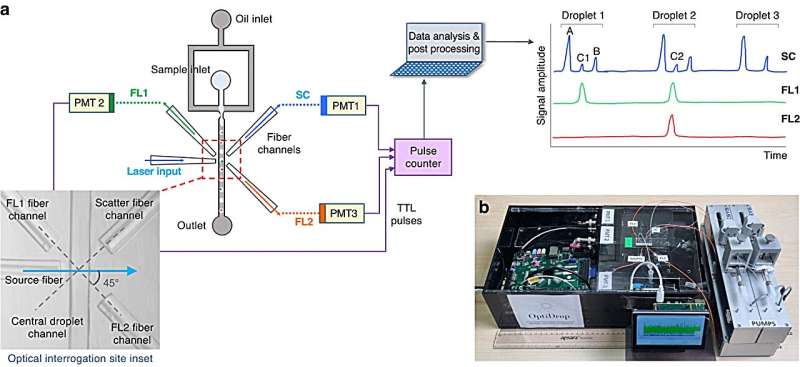This article has been reviewed according to Science X's editorial process and policies. Editors have highlighted the following attributes while ensuring the content's credibility:
fact-checked
peer-reviewed publication
proofread
New single-cell analysis tech incorporates advanced fiber optics directly into microfluidic chips

Droplet microfluidics has revolutionized single-cell analysis, crucial for genomics, drug discovery, and diagnostics, by partitioning samples into nanoliter droplets for detailed cellular analysis. Yet, its broader adoption is hindered by the complex, costly methods required for analyzing droplets' optical properties.
This limitation underscores the urgent need for simpler, cost-effective optical sensing technologies to unlock the full potential of droplet microfluidics in various applications.
A study published on March 12, 2024, in the journal Microsystems & Nanoengineering, unveils an innovative technology that enables multiplexed fluorescence and scatter detection with unprecedented single-cell resolution, using on-chip fiber optics within droplet microfluidic applications.
The innovative technology behind the OptiDrop platform marks a significant departure from traditional single-cell analysis methods. By incorporating advanced optical fiber technology directly into microfluidic chips, OptiDrop enables on-chip detection of light scatter and fluorescence from droplets.
This novel approach allows for precise analysis of cellular components at a level of detail previously considered unachievable, bypassing the need for complex and costly traditional microscopy and high-speed imaging techniques. The platform has been rigorously tested, demonstrating its ability to perform differential expression analysis of cell surface biomarkers, such as major histocompatibility complex proteins.
This not only showcases OptiDrop's potential for detecting subtle biological variations but also highlights its capacity for scalable, high-throughput analysis.
Preksha Gupta, lead researcher on the project, said, "The OptiDrop platform marries the flexibility of flow cytometry with droplet microfluidics' power, offering scalable optical sensing solutions that were previously unimaginable in research and diagnostics."
The OptiDrop platform stands as a testament to the potential of combining microfluidic technologies with advanced optical sensing techniques. By offering a versatile, scalable, and affordable solution for single-cell analysis, OptiDrop paves the way for transformative advancements in biomedical research and diagnostics.
More information: Preksha Gupta et al, Multiplexed fluorescence and scatter detection with single cell resolution using on-chip fiber optics for droplet microfluidic applications, Microsystems & Nanoengineering (2024). DOI: 10.1038/s41378-024-00665-w
Journal information: Microsystems and Nanoengineering
Provided by TranSpread



















